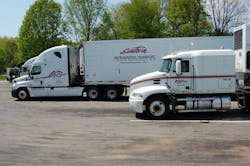Everywhere you go in the freight transportation world, it seems everyone is talking about “Big Data” and how it will influence if not outright change supply chain strategies, logistics operations, even truck maintenance practices.
But here’s a question rarely asked in such discussions: just what exactly is “Big Data” and how should it be defined in the minds of motor carriers?
Fleet Owner asked Steve Mitgang, CEO of SmartDrive Systems – an in-cab video and safety analytics provider – to delve into this topic and provide his take on the meaning of Big Data for fleet operators.
So, Steve, what exactly does the term “Big Data” mean from where you sit?
First, we need to define “Big Data,” as everyone defines it differently. We define it in terms of large volumes of data that overwhelm a business on a day-to-day basis. But it’s not the amount of data that’s important. It’s what organizations do with the data that matters. Big Data can help make big decisions and, ultimately, big changes. Analyzing the data and making it actionable for the organization can lead to better decisions and strategic business moves.
The way we see it at Smartdrive, “Big Data” comes in two distinct forms from both on and off the truck. On the truck, it’s real-time vehicle performance, driving behavior and environmental information in the form of video, sensor and telematics data. Off the truck, it is back-office operational data – including everything from transportation management system information to insurance claims and maintenance records.
The power of Big Data comes from the insight it provides into what happens inside, around and in front of a truck and then by offering a clear way to take action.
For example, on paper, many professional drivers look the same – especially if they have good, safe driving records. However, understanding their actual driving performance can reveal key differences that cost fleets.
So while Driver A and B have similar safe driving records, Big Data will show that Driver A routinely makes U-turns on public roadways – putting himself, the cargo and the fleet at a higher degree of risk. Driving measurable improvement in fleet operations is all about uncovering the less obvious, or hidden, risks while providing that information in an “actionable” format. In this way, by proactively monitoring data and using it to coach drivers, trucking fleets become safer – saving lives, protecting jobs and saving money.
Many fleets are worried that it will cost too much to try and bring “Big Data” based programs into their operations – especially when it comes to safety. How big a concern should cost be?
Processing – and interpreting – Big Data can be costly, particularly for individual fleets trying to do it on their own.
But Big Data plays an important role in calculating an ROI [return on investment]. The key is having the right information, delivered to the right person, at the right time, to take action.
For example, when considering a video-based safety program, it’s important to note that video is just one piece of the puzzle. It’s the contextual information – collected and analyzed in real time and provided in a way that is actionable and measurable – that delivers savings beyond just the exoneration of the driver.
To realize the full ROI, fleets need a platform that has been built with analytics as a core component, one that includes intelligent data collection, advanced algorithms and actionable metrics.
We advise fleets to examine the initial investment for the hardware needed and the expandability of that platform – extra cameras, data integration, etc. – the ongoing monthly service fee, integration options to other systems and the analytics available.Fleets should also examine the investment required against the estimated reductions in collisions, collision cost, and improvements in claims resolution times. Fleets should also expand their ROI by seeking additional savings in fuel from “softer” driving and [engine] idling reduction, with maintenance savings also resulting from “softer” and safer driving habits.
For example, let’s say a fleet equips their vehicles with APUs [auxiliary power units] yet they still have an idling problem. Vehicle profile data can identify and diagnose the root causes of the issue, allowing the fleet to fully understand the cost impact of excessive idling, the drivers who are incurring the highest costs, the time of day/night and location of specific idling instances to determine whether it is justified or not.
Another buzzphrase often attached to “Big Data” is “actionable intelligence” and it usually rings hollow with truck drivers and many fleet managers, too. Explain what that term really means and why it’s important to trucking.
It’s understandable why “actionable intelligence” may ring hollow for drivers. They haven’t seen a lot of it helping them in their day-to-day job. They may only have been at the receiving end of a manager who has some data on a tabular report from one of the on-board systems – and, a little bit of data can be dangerous.Historically, drivers may have interacted with data when they’ve been called into a meeting with their safety or operations manager about their performance. Perhaps they’ve been told they are unsafe because they had 10 hard brakes in the last two days or maybe, they’ve had 25 lane departure warnings. Based on that information alone, they are being coached to be better.
Unfortunately, not only does this information not tell the story of what really happened, but it’s not “actionable” at all by the driver.
In what situations is hard braking actually OK? When is a lane departure dangerous versus a “false positive”? What caused a driver to take the action that he did? Thus it is no wonder truck drivers don’t trust data. This type of information – and the resultant coaching – comes across as arbitrary, open for debate, and largely inaccurate.
With systems that deliver intelligence versus data, drivers have the ability to understand how they are doing on key operational and safety performance metrics and understand what specific actions they can take to improve them. This is what makes it “actionable.”
Drivers also need data to show how they compare to their peers as well as fleet targets. This provides the driver with unbiased information that they can they act on while measuring their own performance improvement. If they need to work on speeding, they know it, and they know if they’ve improved. If texting and driving is an issue, it’s identified and again improvement is measured. If they do something positive that gets measured and can be rewarded appropriately.
Finally, safety is always a given in trucking but some still seem to think of it as a “necessary evil,” something one must do to be compliant with the rules. Can the use of “Big Data” in the safety arena change that?
While the perspective you express may be the case for some fleets, we see that less and less in the fleets with which we engage. And certainly, the fleets who become our customers are those that have recognized that safety and “good for business” are not mutually exclusive propositions.How fleets operate, and the technology that supports them, is in a period of transformational change and “Big Data” – or data intelligence – is at the heart of it. The performance insights that are unlocked by identifying what’s going on in a business, which is only possible by really understanding performance out on the road when a vehicle is in operation, unleashes significant savings and efficiency gains.
In addition, with the rising and, frankly, out-of-control legal costs, I believe most fleets today are looking at every opportunity to save costs by reducing collisions and reducing legal fees.
I’m happy to say that we aren’t meeting with a lot of fleets that think investing in safety doesn’t have business merit. They are focused on what solution is the best fit for what they are trying to accomplish.
It’s important for fleets to realize that predictive solutions – derived from intelligent analytics operating in real time that deliver actionable information at that point in time – are the ones that provide the highest value for the fleet by delivering actual results.
Combining that transformational information in a program that operationalizes the insights is the winning combination: You understand what happened, learn where to focus, recognize what to do, take appropriate actions and then measure your results.
Done well, this is a process that accelerates organizations, frees up time for managers and becomes part of the operational fabric of the organization. That is when the business gets real leverage out of its Big Data investment.
About the Author
Sean Kilcarr
Editor in Chief
Sean Kilcarr is a former longtime FleetOwner senior editor who wrote for the publication from 2000 to 2018. He served as editor-in-chief from 2017 to 2018.




